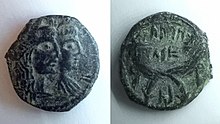Shaqilath

Shaqilath (Nabataean Aramaic: 𐢝𐢚𐢍𐢑𐢞, ŠQYLT;[3] also spelled Shaqilat, Shaqeela, Shaqeelah, Šagīlat) was a queen of the Nabataeans.
She was the second wife and co-ruler of Aretas IV of the Nabataeans[4] in AD 16–40.[5]
She married King Aretas IV in 16 AD[6] and had four children with him: Hagru or Hajir, Malik, Jameelah and Shaqilath II.
Her role as queen and her proximity to the king is emphasized by her title "the Sister of the King".
During the reign of King Aretas IV and Shaqilat, the trades expanded to distant areas in the ancient world and industry, commerce and civilization of the Nabataeans flourished.
Copper and silver coins where she is depicted with her husband have been recovered, and they offer expressive examples and models of the Nabataean civilization in terms of the culture of clothing.[7]
See also
[edit]References
[edit]- ^ Yaʻaḳov Meshorer, "Nabataean coins", Ahva Co-op Press, 1975; 114.
- ^ "Prutah - Aretas IV & Shaqilath, Nabataean Kingdom". en.numista.com. Retrieved Nov 25, 2020.
- ^ "coin | British Museum". The British Museum. Retrieved Nov 25, 2020.
- ^ Jane Taylor (2001). Petra and the Lost Kingdom of the Nabataeans. I.B.Tauris. p. 73. ISBN 978-1-86064-508-2. Retrieved 16 December 2018.
- ^ Auge, Christian; Dentzer, Jean-Marie (2000-05-01). Discoveries: Petra: Lost City of the Ancient World. Harry N. Abrams. p. 120. ISBN 978-0-8109-2896-1.
- ^ The Numismatic Chronicle. Vol. 150. Royal Numismatic Society. 1990. p. 130.
If 29 is the fourth year of Shaqilat then the marriage between Aretas and Shaqilat fell in his 25th year, which corresponds to ad 16.
- ^ Francisco del Río Sánchez (4 December 2015). Nabatu. The Nabataeans through their inscriptions. Edicions Universitat Barcelona. p. 94. ISBN 978-84-475-3748-8. Retrieved 16 December 2018.
